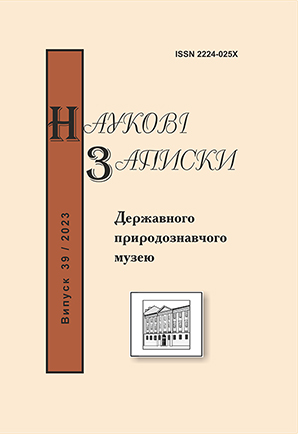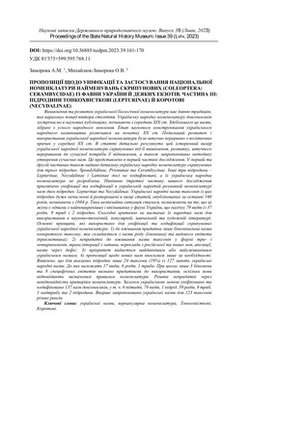Zamoroka A.M., Mykhailiuk-Zamoroka O.V.
Proposals for unification and use of the Ukrainian national nomenclature for native and exotic species of the longhorn beetles (Coleoptera: Cerambycidae) in Ukraine. Part III: subfamilies Lepturinae and Necydalinae // Proc. of the State Nat. Hist. Mus. - Lviv, 2023. - 39. - P. 161-170 DOI: https://doi.org/10.36885/nzdpm.2023.39.161-170 Key words: Ukrainian vernacular nomenclature, the longhorn beetles, Lepturinae, Necydalinae The emerging and development of Ukrainian biological nomenclature has a long tradition that dates back more than a century and a half. The Ukrainian vernacular nomenclature of the longhorn beetles is found in scientific publications, starting from the middle of the 19th century. For the most part, these are names collected from oral folk speech. The stage of scientific construction of the Ukrainian vernacular nomenclature began at the beginning of the 20th century. Further development and use of the Ukrainian vernacular nomenclature was artificially interrupted for political reasons in the middle of the 20th century. We examined in detail this historical dimension of the Ukrainian vernacular nomenclature of the longhorn beetles from its origin, development, artificial interruption to the modern need for its restoration, and also proposed a methodology for the formation of the modern names. This is presented in the first part of our study. In the first and second parts, we also provided a detailed Ukrainian vernacular nomenclature of the longhorn beetles for three subfamilies: Spondylidinae, Prionunae, and Cerambycinae. The other three subfamilies - Lepturinae, Necydalinae and Lamiinae are still not codified, and their Ukrainian vernacular nomenclature has not been developed. The current (third) part of our study is devoted to the unification and codification of the Ukrainian national vernacular nomenclature of the names of two subfamilies: Lepturinae and Necydalinae. Ukrainian vernacular names of taxa from these subfamilies are very few and scattered in a number of papers published over the last 160 years, starting from 1864. Such an unusual situation occurred despite the fact that these beetles are among the most common and recognizable in the fauna of Ukraine, numbering 79 species from 37 genera, 9 tribes and 2 subfamilies. Today, there is a critical lack of their vernacular names for use in scientific, technical, popular, educational and fiction literature. The main principles we used for the unification and codification of the longhorn beetles Ukrainian vernacular nomenclature: 1) only the binomial name of a specific taxon consisting of the name of the genus (noun) and the specific epithet (adjective) is suitable for use; 2) the names of taxa in the form of three- and four-nomen, transliterations from Latin, transfers from Russian and other languages, appositions, names with a hyphen are unsuitable for use; 3) priority is given to the oldest or most used Ukrainian names; 4) proposals for new names were made only if necessary. It was revealed that for the indicated subfamilies, only 24 taxa (19%) out of 127 have Ukrainian vernacular names. These include 17 species, 6 genera, 1 tribe. At the same time, only 3 binomens and 8 specific epithets have been considered suitable for use, since they correspond to the defined rules of nomenclature. The rest are unsuitable due to non-compliance with the criteria of the nomenclature. On the whole, we unified and codified 137 names of the longhorn beetles in the Ukrainian language, including 6 subspecies, 79 species, 1 subgenus, 39 genera, 9 tribes, 1 supertribe and 2 subfamilies. For the first time, we proposed Ukrainian names for 123 taxa of different ranks.
Proposals for unification and use of the Ukrainian national nomenclature for native and exotic species of the longhorn beetles (Coleoptera: Cerambycidae) in Ukraine. Part III: subfamilies Lepturinae and Necydalinae // Proc. of the State Nat. Hist. Mus. - Lviv, 2023. - 39. - P. 161-170 DOI: https://doi.org/10.36885/nzdpm.2023.39.161-170 Key words: Ukrainian vernacular nomenclature, the longhorn beetles, Lepturinae, Necydalinae The emerging and development of Ukrainian biological nomenclature has a long tradition that dates back more than a century and a half. The Ukrainian vernacular nomenclature of the longhorn beetles is found in scientific publications, starting from the middle of the 19th century. For the most part, these are names collected from oral folk speech. The stage of scientific construction of the Ukrainian vernacular nomenclature began at the beginning of the 20th century. Further development and use of the Ukrainian vernacular nomenclature was artificially interrupted for political reasons in the middle of the 20th century. We examined in detail this historical dimension of the Ukrainian vernacular nomenclature of the longhorn beetles from its origin, development, artificial interruption to the modern need for its restoration, and also proposed a methodology for the formation of the modern names. This is presented in the first part of our study. In the first and second parts, we also provided a detailed Ukrainian vernacular nomenclature of the longhorn beetles for three subfamilies: Spondylidinae, Prionunae, and Cerambycinae. The other three subfamilies - Lepturinae, Necydalinae and Lamiinae are still not codified, and their Ukrainian vernacular nomenclature has not been developed. The current (third) part of our study is devoted to the unification and codification of the Ukrainian national vernacular nomenclature of the names of two subfamilies: Lepturinae and Necydalinae. Ukrainian vernacular names of taxa from these subfamilies are very few and scattered in a number of papers published over the last 160 years, starting from 1864. Such an unusual situation occurred despite the fact that these beetles are among the most common and recognizable in the fauna of Ukraine, numbering 79 species from 37 genera, 9 tribes and 2 subfamilies. Today, there is a critical lack of their vernacular names for use in scientific, technical, popular, educational and fiction literature. The main principles we used for the unification and codification of the longhorn beetles Ukrainian vernacular nomenclature: 1) only the binomial name of a specific taxon consisting of the name of the genus (noun) and the specific epithet (adjective) is suitable for use; 2) the names of taxa in the form of three- and four-nomen, transliterations from Latin, transfers from Russian and other languages, appositions, names with a hyphen are unsuitable for use; 3) priority is given to the oldest or most used Ukrainian names; 4) proposals for new names were made only if necessary. It was revealed that for the indicated subfamilies, only 24 taxa (19%) out of 127 have Ukrainian vernacular names. These include 17 species, 6 genera, 1 tribe. At the same time, only 3 binomens and 8 specific epithets have been considered suitable for use, since they correspond to the defined rules of nomenclature. The rest are unsuitable due to non-compliance with the criteria of the nomenclature. On the whole, we unified and codified 137 names of the longhorn beetles in the Ukrainian language, including 6 subspecies, 79 species, 1 subgenus, 39 genera, 9 tribes, 1 supertribe and 2 subfamilies. For the first time, we proposed Ukrainian names for 123 taxa of different ranks.
References
- Бартенев А.Ф. 2009. Жуки-усачи Левобережной Украины и Крыма. Xарків : ХНУ імені В.Н. Каразіна. 418 с.
- Верхратський І. 1869. Початки до уложення номенклятури и терминологиі природописноі, народнёі. Вид. 3. Львів : Печатня Ставропигийського Институту. 23 с.
- Загайкевич І.К. 1958. Комахи-шкідники деревних і чагарникових порід західних областей України. К. : Вид-во АН УРСР. 132 с.
- Загайкевич І.К. 1961. Матеріали до вивчення жуків-вусачів (Coleoptera, Cerambyciae) України. Наукові записки Державного природознавчого музею. Т. 9. С. 52–59.
- Заморока А.М. 2022. Пропозиції щодо уніфікації і застосування національної номенклатури найменувань скрипунових (Coleoptera: Cerambycidae) із фавни України та деяких екзотів. Частина I: підродини куцовусові (Spondylidinae) та фрузеві (Prioninae). Наукові записки Державного природознавчого музею. Вип. 38. С. 207–218. DOI: https://doi.org/10.36885/nzdpm.2022.38.207-218
- Заморока А.М., Михайлюк-Заморока О.В. 2022. Пропозиції щодо уніфікації і застосування національної номенклатури найменувань скрипунових (Coleoptera: Cerambycidae) із фавни України та деяких екзотів. Частина ІІ: підродина козакові (Cerambycinae). Наукові записки Державного природознавчого музею. Вип. 38. С. 219–230. DOI: https://doi.org/10.36885/nzdpm.2022.38.219-230
- Кравченко О.М., Кравченко С.О. 2009. Колеоптероїдні комахи Шацького національного природного парку та прилеглих територій. Жуки-вусачі (Coleoptera, Cerambycidae). Науковий вісник Волинського національного університету імені Лесі Українки. Т. 2. С. 135–143.
- Наказ Міністерства захисту довкілля та природних ресурсів України від 19 січня 2021 року № 29 «Про затвердження переліків видів тварин, що заносяться до Червоної книги України (тваринний світ), та видів тварин, що виключені з Червоної книги України (тваринний світ)». Червона книга Українських Карпат. Тваринний світ. 2011. За ред. О.Ю. Мателешко, Л.А. Потіш. Ужгород : Карпати. 336 с.
- Щоголів І. 1919–1920. Словник української ентомольоґичної номенклятури (проєкт). Київ : Друкарня Українського наукового товариства. 80 с.
- Щоголів І. 1928. Словник зоологичної номенклятури. Частина ІІІ. Назви безхребетних тварин. Evertebrata. (Проєкт). Комахи. Київ : Державне видавництво України. 114 с.
- Zamoroka A.M. 2022a. The longhorn beetles (Coleoptera, Cerambycidae) of Ukraine: Results of two centuries of research. Biosystem diversity. Vol. 30 No 1. P. 46–74. DOI: https://doi.org/10.15421/012206
- Zamoroka A.M. 2022b. Molecular revision of Rhagiini sensu lato (Coleoptera, Cerambycidae): Paraphyly, intricate evolution and novel taxonomy. Biosystem diversity. Vol. 30 No 3. Р. 295–309. DOI: https://doi.org/10.15421/012232
- Zamoroka A.M., Trócoli S., Shparyk V.Yu., Semaniuk D.V. 2022. Polyphyly of the genus Stenurella (Coleoptera, Cerambycidae): Consensus of morphological and molecular data. Biosystem diversity. Vol. 30 No 2. Р. 119-136 DOI: https://doi.org/10.15421/012212


